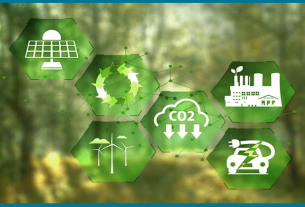
The State of the Energy Union is accompanied by a series of reports covering different aspects of energy and climate policy, including the annual Climate Action Progress Report, the Fuel Quality Report, the Report on the implementation of the Carbon Capture & Storage Directive, the Report on the implementation of the EU Adaptation Strategy and the Carbon Market Report (due for publication next week).
Steady decline in emissions
The EU’s net greenhouse gas emissions decreased by around 3% in 2022 continuing the 30-year downward trend. The EU has achieved steady decreases in its emissions since 1990, reaching a running total in 2022 of -32.5%. COVID lockdown measures in 2020 caused an unprecedented fall in emissions, followed by a strong rebound in 2021. 2022 emissions, however, continue to fall below the 2019 level.
Another positive development this year is that the volume of carbon removed from the atmosphere in the EU increased in 2022 compared to the previous year, based on approximate data. However, based on Member States’ projections, the EU is currently not on track to reach its 2030 objective of removing 310 million tonnes of CO2 from the atmosphere per year.
The EU and its Member States need to significantly step up their implementation efforts and accelerate emissions reduction to stay on track to reach the 2030 -55% net greenhouse gas reduction target and climate neutrality by 2050.
Commissioner for Climate Action, Wopke Hoekstra said: “The past years have been incredibly challenging for Europe, but we have not turned away from our firm belief that the European Green Deal is the answer to both our energy security and our climate challenges. At COP28, Europe will have a strong story to tell. We have made progress on emission reductions, renewable energy deployment, and investing in clean mobility. And we have done this while growing our economy and investing in the clean technologies of the future. Going forward, we will also work to phase out, as soon as possible, any fossil fuel subsidy that does not address energy poverty or the just transition.”
Energy crisis stalls progress in power generation and heavy industry
Emissions from factories and power plants in the EU Emissions Trading Systems (EU ETS) decreased by 1.8% in 2022 compared to the previous year, largely due to impact of the energy crisis in Europe. In the energy sector, emissions even increased slightly for a second consecutive year due to more use of coal in electricity generation. Emissions from industrial production went down because of an increase in inflation and a reduction in industrial demand.
With a robust carbon price, the EU ETS raised some EUR 38.8 billion in auction revenue in 2022, mostly of which went directly to national budgets. Member States on average used 76% of the ETS revenue to support climate and energy projects including social measures in response to the energy crisis.
Emissions from buildings fall, while transport’s footprint continues to grow
Outside the ETS, emissions from buildings, agriculture, small industry, waste and transport went down by 3% overall in 2021. However, there were significant divergences between these sectors covered by the Effort Sharing Regulation. The reductions were driven by the buildings sector and small industry, whose emissions fell by more than 9% and almost 6% respectively compared to 2021. Transport, on the other hand, recorded an increase in emissions of over 2% last year.
Awareness of climate impacts has increased, action on adaptation to climate change must accelerate
Implementation of the 2021 EU Adaptation Strategy requires an all-of-society, all-of government effort. At EU level, a broad range of policies are already implementing adaptation measures. In some areas, such as health policy, adaptation is being mainstreamed at a rapid rate thanks to the European Climate and Health Observatory. Yet, science and Member States’ own reporting identify significant and growing vulnerabilities, for instance for agriculture, water management or energy sector. This growing awareness is an important enabler of further progress in itself. Yet, the evaluation of adaptation policies at national level and their effectiveness in building resilience of communities, economic assets and nature to the increased impacts remains patchy.
The latest Fuel Quality Report covers data from 2021 and finds that the average greenhouse gas (GHG) intensity of fuels in the EU remained 5.5% lower in 2021 than in 2010, the same level reported in the previous year.
Despite the recent shift towards electric vehicles, most road transport in the EU still relies on petrol and diesel, which release harmful air pollutants and emit GHG emissions that contribute to climate change. Road transport is responsible for about 24% of the EU’s GHG emissions and is a sector where emissions are still increasing. In the transition to zero-emission mobility, we need to do more to decarbonise transport fuels and ensure that high-quality fuels are used in the remaining non-electrified fleet.
Today’s report also reveals that thirteen Member States have achieved the target of reducing the GHG intensity of transport fuels and energy by at least 6%. This goal has applied since 2010 and was set out under the Fuel Quality Directive.
In 2021, fossil fuels made up the vast majority of the total fuel supply, with diesel dominating in most EU countries. Meanwhile, biofuels accounted for 6.7% of total 2021 fuel supply, representing a slight increase in comparison to 2020. All diesel and petrol sold in the EU was marketed as containing respectively 7% of biodiesel or 5% to 10% of bioethanol by volume.
Further Information
Climate Action Progress Report
EEA Technical Report on ‘Greenhouse gas intensities of transport fuels in the EU in 2021
